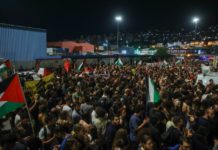By Bill Van Auken
Backed by intense US airstrikes and accompanied by beefed-up contingents of US special operations troops, an armed force dominated by the YPG (People’s Protection Force) Kurdish militia crossed into the eastern sector of the Syrian city of Raqqa Tuesday.
The offensive against the so-called capital of the Islamic State of Iraq and Syria represents a major escalation of the US military intervention in Syria. Ostensibly aimed at crushing ISIS and countering terrorism, the American escalation is bound up with the broader strategic aims of US imperialism, principally, confronting Iran, which is seen as an obstacle to US hegemony in the oil-rich Middle East.
While declining to specify the precise number of US troops now on the ground in Syria, the Pentagon has acknowledged that the number of US “advisers” deployed with the YPG has been increased substantially in the wake of last month’s decision by the Trump administration to directly arm the Kurdish militia.
Thousands of assault rifles, heavy machine guns and antitank weapons along with armored vehicles have been delivered to the YPG. A Pentagon spokesman told the US military newspaper Stars and Stripes that part of the mission of the special operations troops deployed with the Kurdish militia is to “closely monitor the equipment provided to the Syrian Kurds” and “ensure it’s not going to be pointed in any different direction other than ISIS.”
Turkey, Washington’s NATO ally, has bitterly denounced the arming of the Kurdish militia, which Ankara regards as a “terrorist” force and a branch of the Kurdistan Workers Party (PKK), with which it has been in armed conflict for decades.
The Turkish government has threatened to intervene in Syria if it perceives the Kurdish offensive in Raqqa posing a threat to its interests. At the same time, Prime Minister Binali Yildirim reported that Washington had assured Ankara that its support for the YPG would end once the Raqqa offensive was completed. A senior State Department official recently described the US relation to the Syrian Kurds as “temporary, transactional and tactical,” signaling that Washington will betray the Kurds as soon as they have served their purpose.
While the number of American troops deployed in Syria had officially been capped at 500, they are now believed to number well over 1,000. In addition to the special operations troops fighting alongside the YPG, a US Marine artillery unit is pouring howitzer fire into the besieged city and US Apache attack helicopters are providing close air support.
The main factor in the steady advance of the YPG on Raqqa, however, has been an intense US bombing campaign that has exacted a growing toll in terms of civilian lives. The monitoring group Airwars has conservatively estimated over 3,800 killed since the US first launched its airstrikes in Iraq and Syria in 2014. Over 60 percent of these casualties have been inflicted since the beginning of this year.
US and allied warplanes have dropped leaflets over Raqqa telling residents to leave their homes. Those who attempt to do so, however, face the prospect of being killed by US warplanes, being shot by ISIS militants or being blown up by mines planted around the city.
On Tuesday, there were reports from both Syrian government media and opposition sources that a US strike killed at least 12 civilians, including women and children, as they attempted to flee the city by boarding boats to cross the Euphrates River. A total of 21 civilians were killed Monday night in air strikes on Raqqa, according to the British-based Syrian Observatory for Human Rights.
Also on Tuesday, a school housing civilians displaced by the fighting was hit by US bombs in the eastern Mashlab district of Raqqa, causing an unknown number of civilian casualties.
Last Saturday, a US airstrike hit a residential building in Raqqa, killing 43 civilians, most of them women and children. The al-Mawasah hospital in the city was also reportedly hit by warplanes from the US-led coalition, with a number of civilians, including women and children, killed and wounded.
The assault on Raqqa comes barely one week after US Secretary of Defense James Mattis told the media that the Pentagon has adopted “annihilation tactics” in its anti-ISIS campaign, centered on the parallel sieges against the Syrian city of some 300,000 people and Mosul, the Iraqi city 230 miles to the east, which previously had a population of 1.6 million people. “Civilian casualties are a fact of life in this sort of situation,” Mattis, a former Marine general, said of the ongoing US-led offensives. The comments, it is now undeniably clear, represented a green light to US commanders to carry out mass slaughter.
Media reports and statements from the Pentagon and the YPG have all indicated that Raqqa is besieged from the north, east and west. Reports from both the Russian and Iranian media, however, have suggested that the US and its proxy forces have deliberately left an escape route for ISIS fighters to the south, allowing them to flee to the city of Deir al-Zour, about 85 miles down the Euphrates, where the Islamist militia has launched an offensive against Syrian army forces. The surrounding province of Deir al-Zour is almost entirely controlled by the Islamist militias that have served as proxy forces in the six-year-old US-backed war to topple the Syrian government of President Bashar al-Assad. Heavy fighting has also taken place between ISIS and government forces around the ancient city of Palmyra, 100 miles south of Raqqa.
Even as Syrian government forces were fighting ISIS in Deir al-Zour and Palmyra, further south, in the al-Tanf area near Syria’s borders with Iraq and Jordan, the US carried out an airstrike against pro-government forces, attacking a column the Pentagon claimed included a tank, artillery, antiaircraft weapons, vehicles and more than 60 soldiers. It was not clear how many were killed and wounded in the US bombing. The US military has illegally established a base on Syrian territory there to train so-called “rebels,” allegedly to fight ISIS. The US military carried out a similar attack on pro-government militia forces in the same area last month.
In reality, the Pentagon is training these forces as part of the regime-change operation against Damascus that Washington has orchestrated since 2011, with Al Qaeda-linked Islamist militias serving as its proxy forces.
The simultaneous combat in Deir al-Zour, Palmyra and al-Tanf make clear that Washington is in a de facto military alliance with ISIS, so long as it is attacking government forces.
US military aims in Syria are driven not by a determination to crush ISIS, which is itself the product of US interventions in the region and the CIA’s support for Islamist militias in both Libya and Syria, but rather to overthrow the Syrian regime and militarily confront its principal regional ally, Iran.
The duplicity of US policy in the region has only been underscored by the ongoing crisis in the Persian Gulf, where Saudi Arabia and its allies have imposed a blockade that falls just short of a state of war against Qatar. US President Donald Trump signaled his support for Riyadh in the conflict Tuesday, using his Twitter account to portray the move against Qatar as driven by concern over the Qatari regime’s funding of “Radical Ideology.”
This is patent nonsense. The Saudi regime is itself the principal ideological font of outfits like Al Qaeda and ISIS. Both Saudi Arabia and Qatar have provided billions of dollars worth of support to the Islamist militias that have laid waste to Syria.
Qatar, meanwhile, hosts the forward operating headquarters of the US Central Command, along with over 8,000 US troops and the main American airbase in the region, from which most of the US airstrikes are being launched.
The show of support from the Trump White House for the anti-Qatar campaign is driven by the centrality of war preparations against Iran, with which the Qatari regime has failed to align itself unequivocally.
The episode has served to expose the threat of the US interventions in Iraq and Syria rapidly exploding into a region-wide war drawing in not only Iran, but potentially nuclear-armed Russia.











